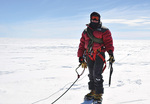When three worlds collide
 Geology Geology
A University of Adelaide geologist who spent three months in the Antarctic last year researching the earth's crust has returned with evidence of how Gondwana was formed 500 million years ago. Dr Kate Selway, an Australian Research Council Postdoctoral Fellow, led an expedition to carry out the largest magnetotelluric (MT) survey of the Antarctic, capturing 2D images of collision zones beneath the ice. Last month she revealed her findings in a free public lecture at the third Research Tuesdays seminar for 2010. "We now know more about the formation of Gondwana, the earth's last great supercontinent that included Australia, Antarctica and India around 500 million years ago," Dr Selway said. Dr Selway was joined in the Antarctic by PhD student Jared Peacock and Honours student Campbell Harvey from the Discipline of Geology and Geophysics. The trio worked in temperatures as low as -15 degrees, setting up instruments on the ice to record data from depths of up to 70 kilometres. "We found what we expected - a fault zone in the crust beneath the Sorsdal Glacier, showing evidence that the geological history north of the glacier is very different to the south," Dr Selway said. The freezing conditions posed some special challenges for the researchers, particularly in regard to their equipment. So that tiny voltage differences could be recorded through thick layers of ice, the signal used in the team's sensing equipment needed to be boosted using special amplifiers. The instruments also needed to be kept warm to record accurate data. "We lined the instrument boxes with thermal foam insulation and ensured the batteries did not get cold because they lose power very quickly in freezing temperatures. We also had to use cables rated to cold temperatures so they would not crack in the conditions." The trio helicoptered out each day from Davis station to do their work, flying over glaciers and the ice shelf and living among penguins, seals and whales. About 80 other people were working at the Antarctic Station during the same period, including scientists, tradespeople, pilots, engineers and chefs, all on various missions. "It was an amazing experience," Dr Selway said. "We always had to take emergency food and shelter with us in case we were stuck on the ice for any reason. A field officer trained in mountaineering, glacier travel and search and rescue was also with us almost all the time. The main safety danger on the ice was the possibility of falling into a crevasse - hence we were roped together when walking across the ice." The project was supervised by Associate Professor Alan Collins, who stayed in Adelaide, and also supported by Professor Graham Heinson, Head of Geology and Geophysics, and Goran Boren, the MT technician. Dr Selway is hoping to use the same electromagnetic survey technique to revisit the Antarctic and look at some of the main zones of collision between Australia, India and Antarctica during the formation of Gondwana. "These areas are further from any of the existing base camps in the Antarctic so it would add another level of complexity to the expedition. "We also want to collaborate with glaciologists who are using geophysics to image glaciers and determine their thickness and how fast they are melting." Dr Selway's team will submit an application to the Australian Antarctic Division this year to undertake the second stage of their research. Story by Candy Gibson
|





